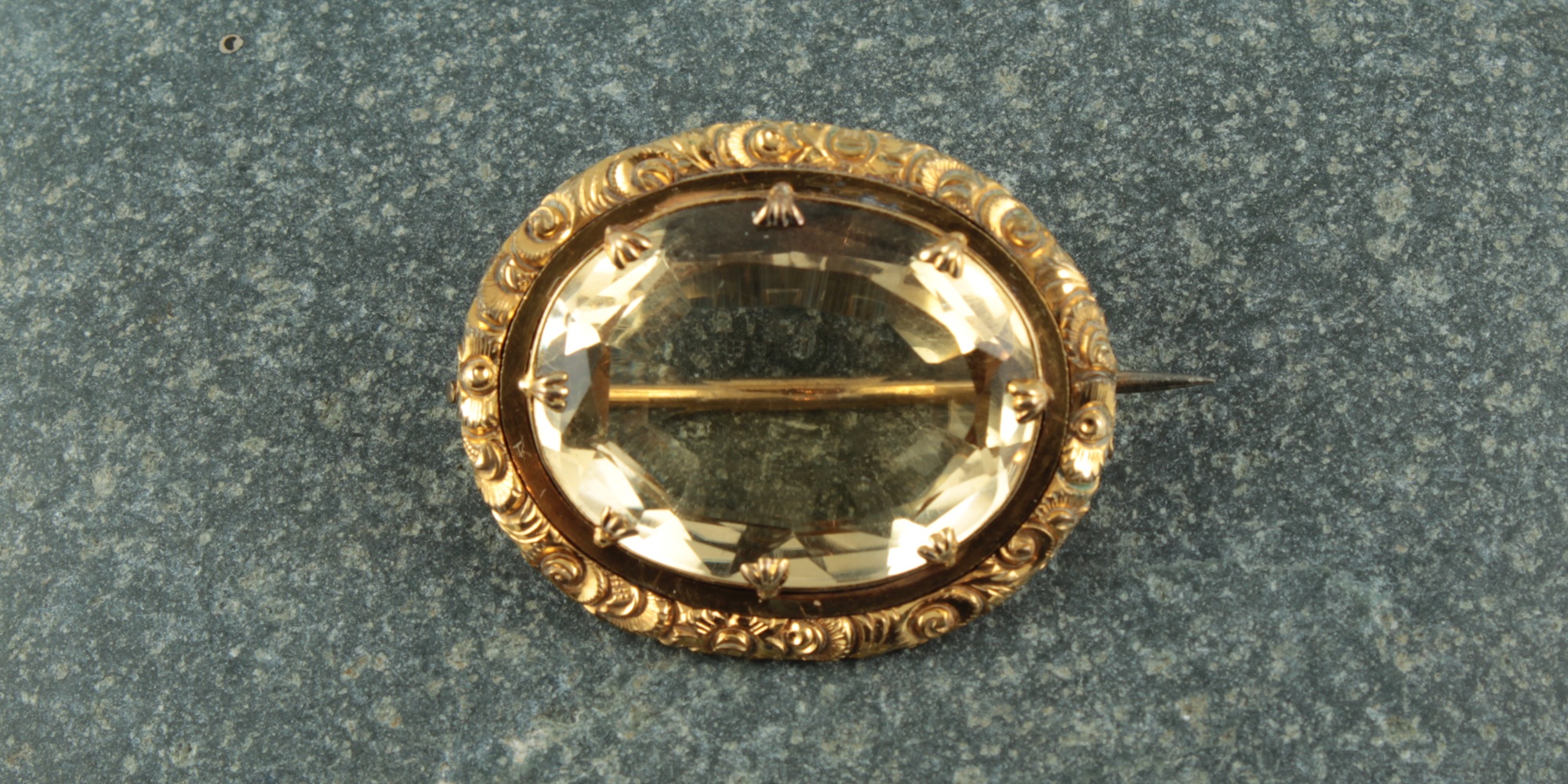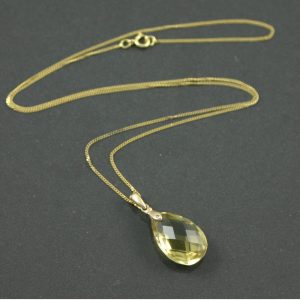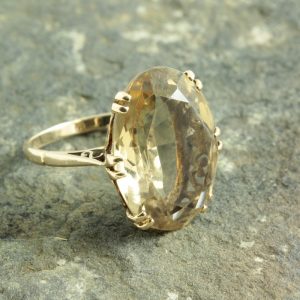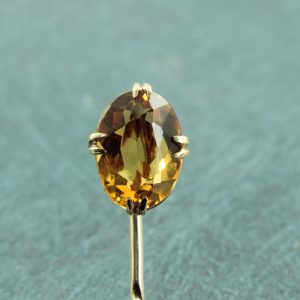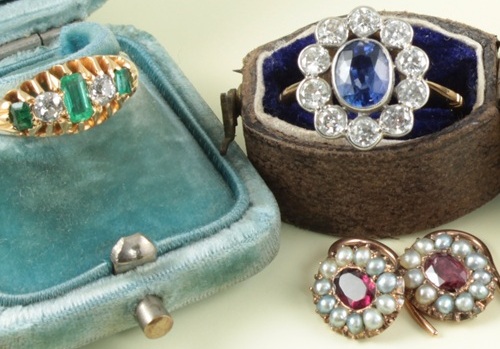Citrine
The name Citrine originates from the Latin word “Citrina” meaning yellow and the French word “Citron” meaning lemon colour. Citrine is comprised of silicon dioxide, with iron being the colouring agent. Most natural citrine is typically a light or pale yellow colour. Madeira Citrine has a deep saturated reddish-orange colour and is considered the most valuable. Citrine belongs to the quartz mineral group. Other well-know gemstones in the quartz family include Agate, Amethyst, Rock Crystal, Smoky Quartz, Rose Quartz and Carnelian. Natural forming Citrines, both light yellow and Madeira are quite rare. The vast majority of Citrine gemstone available on the market is actually heat-treated Amethyst or Smoky Quartz.
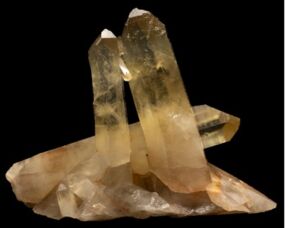 Formation: There are a number of ways in which Citrine can form naturally. The first, a silica-rich solution will begin to crystallise in cavities or fissures in igneous rock. Under the correct conditions of high temperature and pressure, the iron content in the forming crystal will rearrange itself and turn a light yellow colour. The exact conditions required for Citrine to form in this manner, is extremely rare to occur. The second way in which Citrine forms naturally is from Amethyst. The Amythst crystal will form first, from a silica-rich solution. Then over time the required high temperature and pressure will come about from geological processes. The iron content within the Amethyst crystal will rearrange and so result in a yellow colour. Amethyst crystal which contains a higher percentage of iron will turn more orange to deep orange in colour, known as Madeira Citrine. This method of formation is more common than the first method. The process can be seen in some Amethyst geodes, when opened some of the crystals will be Amethyst and some will be Citrine within the same geode. The other method of formation is when Smoky Quartz is subjected to heat and pressure, the iron content will rearrange and turn yellow. So forming Citrine from Smoky Quartz in the exact same process as forming it from Amethyst. All naturally formed Citrine gemstone displays a weak to moderate dichroism. Dichroism is the gemstone`s ability to change colour when viewed from a different angle. It is thought to be caused by the presence of aluminum-based colour centres in natural Citrine. Artificial heat-treated Amethyst or Smoky Quartz which has been turned into Citrine does not display dichroism.
Formation: There are a number of ways in which Citrine can form naturally. The first, a silica-rich solution will begin to crystallise in cavities or fissures in igneous rock. Under the correct conditions of high temperature and pressure, the iron content in the forming crystal will rearrange itself and turn a light yellow colour. The exact conditions required for Citrine to form in this manner, is extremely rare to occur. The second way in which Citrine forms naturally is from Amethyst. The Amythst crystal will form first, from a silica-rich solution. Then over time the required high temperature and pressure will come about from geological processes. The iron content within the Amethyst crystal will rearrange and so result in a yellow colour. Amethyst crystal which contains a higher percentage of iron will turn more orange to deep orange in colour, known as Madeira Citrine. This method of formation is more common than the first method. The process can be seen in some Amethyst geodes, when opened some of the crystals will be Amethyst and some will be Citrine within the same geode. The other method of formation is when Smoky Quartz is subjected to heat and pressure, the iron content will rearrange and turn yellow. So forming Citrine from Smoky Quartz in the exact same process as forming it from Amethyst. All naturally formed Citrine gemstone displays a weak to moderate dichroism. Dichroism is the gemstone`s ability to change colour when viewed from a different angle. It is thought to be caused by the presence of aluminum-based colour centres in natural Citrine. Artificial heat-treated Amethyst or Smoky Quartz which has been turned into Citrine does not display dichroism.
Treatment: The vast majority of Citrine gemstone on the market is heat-treated Amethyst or Smoky Quartz. Brazilian Amethyst will turn light yellow at 470 degrees celsius. It will turn a dark yellow to red-brown when heated to 550 – 560 degress celsius. The percentage of iron contained in the Amethyst gemstone will determine the final colour when heat treatment is applied. The higher the iron content, the darker the final colour. Smoky Quartz will turn yellow at about 200 degrees celsius.
Prasiolite: In the Minas Gerais region of Brazil there is the Montezumt deposit. Violet coloured Amethyst or yellowish Quartz from this deposit can be heat-treated to 500 degress celsius. Which will produce a soft green colour gemstone, known as Prasiolite. Prasiolite gemstone is not formed in nature and is considered sensitive to sunlight, prolonged exposure will cause it to fade.
Durability: Citrine has a hardness rating of 7 on the Mohs scale. Which makes it suitable for everyday use and is considered reasonably resistant to scratches. Citrine is sunlight sensitive, with prolonged exposure causing the gemstone to fade in colour. It is also sensitive to heat which can cause a colour change. So it is recommended to store your Citrine jewellery in a soft cloth pouch when not being worn and away from any direct sources of heat.
Madeira Citrine: The name “Madeira” is a term or trade name used to describe the particular colour of this variety of Citrine. The colour closely resembles the colour of the Portuguese Madeira wine, ranging in shades from golden-orange to deep reddish-orange. The term does not refer to the Portuguese island of Madeira. The primary source of high-quality Madeira is in Brazil. There are also other deposits of Madeira in Uruguay, Zambia and Madagascar.
Meaning and Healing Properties
Citrine has long symbolised abundance, prosperity and success. The stone is also associated with positive energy, joy and optimism. It is said to clarify the wearers thoughts, help with making decisions and so promote new beginnings. Throughout time, the gemstone has been credited with a number of healing properties. It promotes good digestion, helps to increase blood circulation, improve and strengthen the immune system. The gemstone is also credited with balancing hormones and helping with fatigue.
Citrine is the gemstone for the 13th Wedding Anniversary. The stone is said to promote happiness, joy, create abundance and foster new beginnings within an already long-lasting marriage.
Chakra: Citrine is associated with the solar plexus chakra, helping with personal empowerment, confidence and self-worth. The solar plexus chakra is also said to be the source of a person`s willpower and ambition. This gemstone also works with the sacral chakra, helping with emotional energy and creating a sense of inner peace.
Birthstone: Citrine is the birthstone for November, symbolising joy and abundance. Topaz is November`s other birthstone.
Zodiac Astrology: Citrine gemstone is most closely associated with the star sign Sagittarius. The gemstone is also associated with Aries, Leo, Gemini and Scorpio.
History
The earliest known use of Citrine was in Egypt. It has been found in ancient archaeological sites there and was associated with the sun god Ra, because of its colour, which was believed to be derived from sunlight. The gemstone was also associated with the goddess Sekhmet. The stone was worn by Pharaohs and high priests in the belief that the stone held the power of the sun.
In Ancient Greece and Rome, during the Hellenistic period ( 323BC to 31BC ), the gemstone`s popularity became widespread. It has been found in the hilts of swords and daggers. It was also widely used to make intaglio seals and signet rings. These carved seals and rings were commonly used to stamp wax seals on official documents.
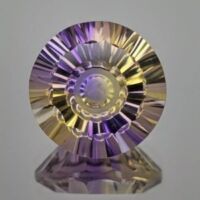 Natural Citrine was discovered in the Anahi mine in Bolivia in 1660. It is said that the mine was given to a Spanish Conquistador as part of his dowry when he married Princess Anahi of the Ayoreos tribe. However, the mine was lost through time and remained undisturbed for over three centuries before being discovered in the 1960s. The Anahi mine is the world`s only commercial source of Ametrine. Ametrine is part Amethyst and part Citrine within the same crystal. This unique combination of colours is the result of the very specific geological conditions which were present during the crystal`s formation. Following the rediscovery of the mine, Ametrine started to become available on the market in the 1970s. Production at the mine continues today, with about 2.5 to 3.5 tons of high-quality gemstone being produced each year. Amethyst accounts for about 44% of the mine`s output, with Ametrine at 33% and Citrine at 23%.
Natural Citrine was discovered in the Anahi mine in Bolivia in 1660. It is said that the mine was given to a Spanish Conquistador as part of his dowry when he married Princess Anahi of the Ayoreos tribe. However, the mine was lost through time and remained undisturbed for over three centuries before being discovered in the 1960s. The Anahi mine is the world`s only commercial source of Ametrine. Ametrine is part Amethyst and part Citrine within the same crystal. This unique combination of colours is the result of the very specific geological conditions which were present during the crystal`s formation. Following the rediscovery of the mine, Ametrine started to become available on the market in the 1970s. Production at the mine continues today, with about 2.5 to 3.5 tons of high-quality gemstone being produced each year. Amethyst accounts for about 44% of the mine`s output, with Ametrine at 33% and Citrine at 23%.
Scotland has a long association with Citrine. Cairngorm stone, which is a variety of Citrine, typically ranging in colour from yellow-brown to dark brown. Its mining and use by the Celts can be traced as far back as 300BC. In the 17th century, Cairngorm stone became quite popular in Scotland. It was used in the hilts of swords and daggers, kilt pins, bonnet brooches and in jewellery in general.
During the 19th Century, Citrine became very popular. In part due to its availability from Brazil and in part from Queen Victoria`s love of the stone and her love of Scotland. Large quantities of Citrine jewellery was produced during this period in Scotland. Which was very popular with tourists travelling through Scotland at the time.
The Art Deco period in the 1920s and 1930s saw a resurgence in the gemstone`s popularity. The discovery of large deposits in Brazil and Uruguay lead to increased supply and reduced cost. Statement jewellery featuring large Citrine gemstones became the height of fashion. With Hollywood stars such as Greta Garbo wearing large citrine cocktail rings and similar jewellery, fueling its popularity.
Today Brazil is the world`s largest producer of high-quality Citrine. Other significant deposits are located in Madagascar, Russia and Bolivia.
Folklore
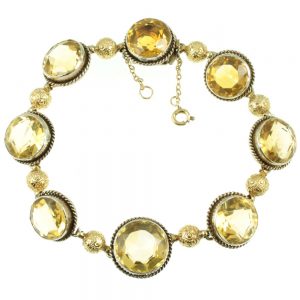 Citrine has had many beliefs associated with it throughout time. In ancient Egypt, the stone was associated with the sun god Ra. They believed the stone`s colour was sunlight captured and so held it held the power of the sun within it. Egyptians also associated the gemstone with the goddess Sekhmet. The lion-headed goddess of war, destruction, plague, healing and fire. Sekhmet symbolised protection and solar energy. They believed the gemstone could protect them from venomous snake bites, evil thoughts and evil spirits. It was a highly prized gemstone, worn by Pharaohs and high priests.
Citrine has had many beliefs associated with it throughout time. In ancient Egypt, the stone was associated with the sun god Ra. They believed the stone`s colour was sunlight captured and so held it held the power of the sun within it. Egyptians also associated the gemstone with the goddess Sekhmet. The lion-headed goddess of war, destruction, plague, healing and fire. Sekhmet symbolised protection and solar energy. They believed the gemstone could protect them from venomous snake bites, evil thoughts and evil spirits. It was a highly prized gemstone, worn by Pharaohs and high priests.
Greek mythology: In ancient Greece, the gemstone was associated with Demeter goddess of the harvest and fertility. To the ancient Greeks, the stone held the power to bestow prosperity, abundance and good luck upon the wearer. They also believed the stone could protect them from evil. The stone was very popular in ancient Greece and often used to create intaglios and signet rings, as well as other jewellery.
Roman mythology: In Roman mythology, Citrine is associated with Apollo god of the sun. They believed that the stone would bring success to the wearer, especially in times of war. For this reason, the stone was frequently used to decorate the hilts of swords and daggers. The stone was also thought to protect the wearer against evil and evil thoughts. They also linked the stone to Bonus Eventus, the god of agriculture and good outcomes. Bonus Eventus personified success, Romans believed that by carving the image of Bonus Eventus ( or other deities ) into a Citrine gemstone then the connection between the wearer and the deity would be increased. The “Depiction of Bonus Eventus” from the 1st century is a stunning example of this. This oval-shaped cameo has been beautifully carved with his image, which can be seen at the J. Paul Getty Museum.
Medieval Europe: During the middle-ages in Europe, the gemstone became known as the “Merchant`s Stone” from the belief that the gemstone could bring wealth and prosperity to the wearer. Its golden colour was associated with gold and wealth. Merchants would keep the stone in their cash boxes to attract further wealth, they also wore it to bring success in their business dealings. During this time it was also known as the “Philosopher`s Stone” and was widely believed to hold the secrets of the universe. Alchemists linked the stone to the element of fire and used it in various experiments. Such as trying to turn base metals into gold, changing negative energy into positive energy and in their quest to find the fountain of youth.
There was widespread belief among Celtic people during the middle-ages that the gemstone could protect them from the black death. As well as protecting them from bad skin, venomous snake bites and evil thoughts. They also believed it to help with insomnia and nightmares.
Famous Citrines
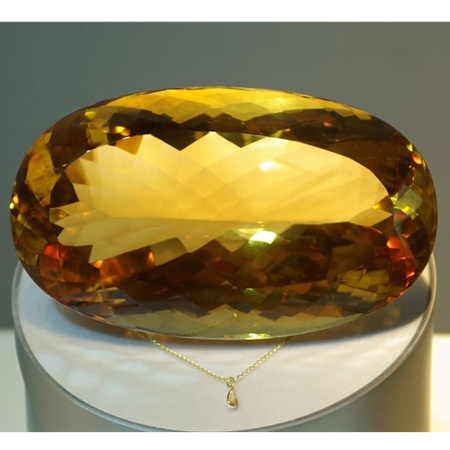
The Malaga Citrine

Citrine Tiara – Queen Sirikit
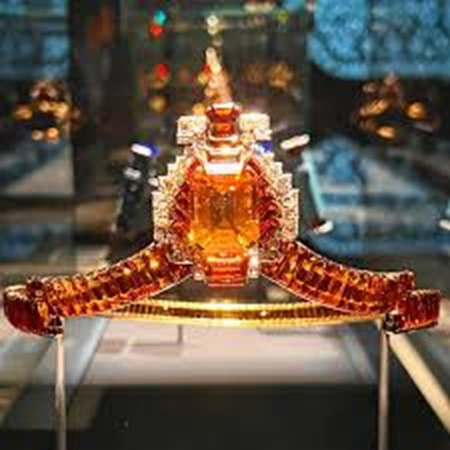
Citrine Tiara by Cartier, 1937
Citrine Gemological Data
Colour: Light to dark yellow, gold to brown.
Colour of Streak: White.
Moh`s hardness: 7
Density: 2.65
Cleavage: None.
Fracture: Conchoidal, very brittle.
Crystal system: Trigonal, hexagonal prisms with pyramids.
Transparency: Transparent.
Chemical composition: SiO2 silicon dioxide.
Refractive index: 1.544 – 1.553
Double refraction: +0.009
Pleochroism: Natural, weak light yellow to yellow.
Dispersion: 0.013
Fluorescence: None.
For Researchers and Journalists: Citing This Article
Recommended Citation (MLA) Format:
Hoyne, John. “Citrine Gemstone: Meaning, History and Folklore.” Carus Jewellery, n.d., https://carusjewellery.com/citrine/.
You can also get in touch with Carusjewellery.com on Facebook , were you may leave any comments or questions you may have about this article.

